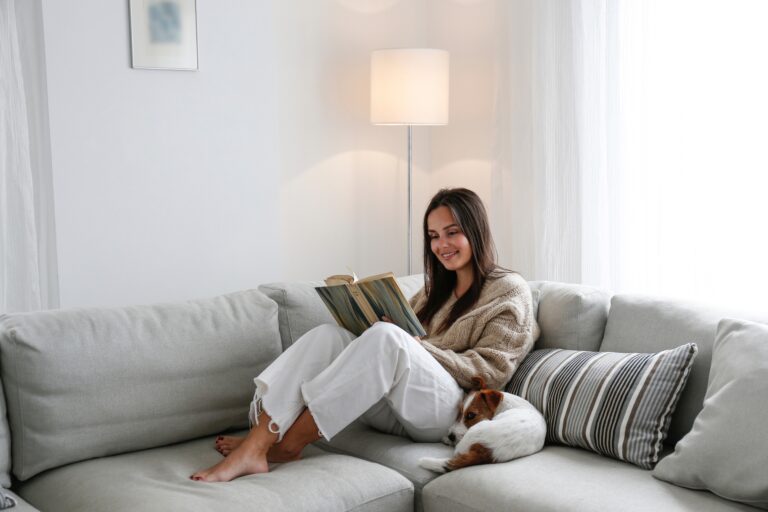In Victoria, British Columbia, each square foot must be maximised when it comes to small rooms in houses. Even though limited space can pose a decorating challenge, proper interior painting tips can be utilised to make the spatial perception more expansive and the atmosphere more airy.
Let’s explore the secrets of picking paint colours and finishes to make an impression of enlarging small interior spaces. We’ll also discuss techniques for creating the illusion of height or width through strategic painting.
Choosing the Right Colours
1. Light vs. Dark Colours
Light Colours
Advantages: The light is reflected, the perception of the place opens up, and the rooms appear more airy and spacious.
Disadvantages: It may seem boring and empty if there is no other element to balance it.
How Light Colours Can Make a Room Feel Larger
Reflective properties: Lighter colours reflect light from sunlight and artificial sources, thus creating an impression of space that feels brighter, larger, and open.
Psychological effect: Light colours, generally associated with openness, can create a psychological effect of significantly expanding a room’s perceived size.
Dark Colours
Advantages: Use the colours to create an environment with layers, depth, and some mystery, and conceal any imperfections that might appear.
Disadvantages: They absorb light, which can be visually claustrophobic when used abundantly.
Using Dark Colours Strategically for Depth and Contrast
Accent walls: Painting one wall with a darker shade of paint can create depth, contrast, and volume without overcrowding the space.
Balancing dark and light: Combining dark colours with light or neutral ones will produce a space that looks balanced and pleasing to the eye.

2. Neutral Colours
Benefits of Neutral Colours in Small Spaces
Versatility: The neutral colours are a timeless background, making decoration alterations easier without having to paint over again.
Light-enhancing: The hues of neutral colours reflect light, giving rooms a feeling of brightness and a spacious atmosphere.
Easy to accessorise: Neutrals will serve as a neutral base for adding highlights of colour as you add furniture, artwork, or other details you like.
How to Choose the Right Neutral Tones
Consider undertones: Pick among the warm and cool undertones to achieve the kind of atmosphere you prefer (e.g., for a cosy feeling, the warm undertones; for a calming feeling, the cool ones).
Test samples: Be sure to place different paint swatches on the wall and observe how they look under other lighting conditions before you make a final decision.
Using Accents to Add Depth and Interest
Texture: Texture can be achieved using textiles, furniture, and decoration to make a neutral space more interesting and visually attentive.
Pops of colour: Incorporate brightly coloured accessories such as throw pillows, rugs or paintings to personalize a neutral colour palette.
Using Paint Finishes Effectively
1. Glossy vs. Matte Finishes
How Glossy Finishes Reflect Light and Create the Illusion of Space
Reflectivity: High glossy appearances give an impression of brighter and more spacious environments, while relatively matte finishes are subtler and will create a calmer and more intimate space.
Depth and dimension: Glossy surfaces allow distinctive architectural features to shine and lengthen small spaces.
Using Matte Finishes for a Cozy Feel
Light absorption: Matte finish is the perfect choice for those who wish to reduce brightness and create a softer, more intimate atmosphere in their bedrooms, living rooms, and cozy spots.
Hiding imperfections: With its low reflective feature, the matte finish will cover any wall with an imperfection or an uneven texture.
Combining Finishes for Depth and Interest
Accent walls: Apply a gloss on the accent wall to emphasise its features and highlight the point of focus.
Trim and doors: Pick a matte finish on the trim and door to balance lighting and increase room volume.
2. Satin Finishes
Advantages of Satin Finishes in Small Rooms
Durability: Satin finishes are tougher and more maintenance-friendly than flat/matte ones. They are usually preferable for areas with heavy traffic.
Light reflection: Satin-textured finishes reflect light but in less intense amounts than glossy finishing. Therefore, a satin finish can add a faint shimmer to light, making the rooms feel brighter.
How Satin Finishes Can Make Walls Appear Smoother
Smooth appearance: The flat and silky finish adds a discreet and nice effect to walls and hides almost any cosmetic defects walls might have.
Light diffusion: The satin finish diffuses light, decreasing the light’s reflection and giving you a more balanced, fair distribution in the room. The effect results in a softer light that is comfortable for your eyes.
Tips for Using Satin Finishes in Different Areas of the Room
Walls: Use satin finishes on walls in high-traffic areas like hallways, kitchens, and children’s rooms for easy care and longevity.
Trim and moulding: Highlight trim and moulding with a satin finish; this can create a contrast with walls, which results in a clean and beautiful look.
Ceilings: Consider using a satin finish on the ceiling to reflect the light and visually grow the height of a room, thus creating a thought of spaciousness.
Transform your small space with Van Isle Paint’s expert interior painting services in Victoria, BC. Our superior quality materials and environmentally conscious approach ensure enduring beauty. Whether you need a residential or commercial painting solution, our expert painters provide personalised painting services. From eco-friendly options to epoxy coatings, we offer various services to suit your needs.
Sincerely,
Van Isle Paint
Victoria, BC, and Beyond
(250) 412-3885
For further insights and informative content from Van Isle Paint, please visit our blog: http://vanislepaint.com/blog/




